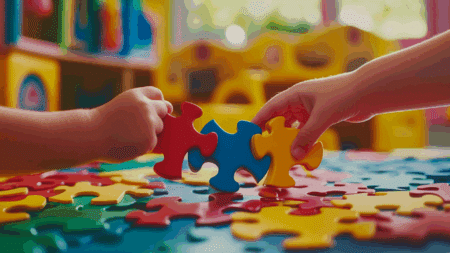A calm classroom feels good. When things run smoothly, teaching becomes easier. That’s where classroom routines come in.
Routines make a big difference. They help the day go from messy to organized. You don’t have to keep saying the same things over and over. That saves you time and energy.
Kids do better, too. When they know what to do and when to do it, they behave better, stay on task more, and feel more ready to learn.
In this blog, we’ll walk you through easy classroom routines you can start using right away.
Why We Need Classroom Routines
Think about how much time gets lost when students don’t know what to do. They wait, ask over and over, or just do nothing.
That’s where routines really help. Once students learn what to do during common parts of the day—like handing in work, moving between tasks, or getting ready to go home—things move faster and smoother.
Routines also help with behavior. Instead of correcting the same things all day, you can point back to what the routine is.
Students often act out when they’re unsure or confused. Routines take away that guesswork. They bring order and calm. They also free up your attention.
You don’t have to focus on the small stuff every five minutes. Instead, you can devote more time to helping students learn, answering questions, or checking in with kids who need extra support.
So routines aren’t just helpful—they’re necessary for a well-run classroom.
Essential Classroom Routines
Having clear and steady routines in your classroom helps a lot. They make things more organized, help students stay on track, and create a space where learning can happen more easily, for any grade level.
Morning Routines

- Entering the Classroom: Students enter quietly, put away their belongings, and prepare for the day’s activities.
- Morning Work/Bell Ringer: As soon as students arrive, they are given a short, engaging task, such as a math problem or journal prompt.
- Attendance and Lunch Count: Students mark their attendance and choose their lunch options in an organized, quick manner.
- Setting Up Classroom Materials: Students gather the materials they need for the day from their designated spots or cubbies.
- Turning in Homework: A routine is established where students place completed homework in a specific tray or folder.
- Teacher Greeting: The teacher greets students with a smile, handshake, or a short greeting to create a positive start to the day.
- Visual Schedule Review: The teacher displays a visual schedule for the day so students know what to expect.
- Class Job Assignment: A student is assigned a small class task for the day, like being the line leader or board cleaner.
- Quiet Time/Personal Reflection: Students have a brief moment for personal reflection or mindfulness to settle in for the day.
- Classroom News or Announcements: The teacher shares important news or announcements, such as birthdays or upcoming events.
Transition Routines

- Moving from Desk to Group Work: Students move to designated areas for group activities quietly and efficiently.
- Bathroom Breaks: A routine for requesting permission and using the bathroom, ensuring minimal disruption.
- Moving Between Classroom Activities: Clear procedures for transitioning between subjects or activities, such as math to reading, with minimal downtime.
- Line-Up for Recess or Lunch: Students line up in designated spots, stay quiet, and wait for the teacher’s signal to proceed.
- Changing from Independent Work to Partner Work: Students quickly and smoothly transition from solo tasks to working with a partner or in small groups.
- Transitioning to a New Topic: Students follow a structured process for switching focus from one subject or task to another.
- Entering the Classroom After a Break: A clear routine for returning from recess, lunch, or other breaks, with students settling in quickly.
- Switching Between Online and In-Person Activities: A routine to help students transition smoothly between digital learning activities and in-person lessons.
- Moving from Class to Special Subjects (e.g., Art, Music): Clear expectations for transitioning between the main classroom and special subject areas.
- Packing Up for Dismissal: Students follow a routine for collecting their belongings, making sure everything is in place before leaving.
Work Completion Routines

- Turning in Homework: Students place completed homework in a specific tray or folder for collection.
- Finishing Work Early: Students know what to do when they finish work early, such as reading a book, journaling, or working on a different assignment.
- Organizing Completed Assignments: Students organize and label their assignments before turning them in to ensure proper filing.
- Asking for Help: Students follow a routine for asking questions or requesting help without disrupting others.
- Self-Checking Work: Students are encouraged to review and correct their work before turning it in.
- Peer Review: Students exchange work with a partner to check for errors and provide constructive feedback.
- Using a Checklist: Students are provided with a checklist to self-monitor their tasks and ensure they’ve completed everything.
- Submitting Digital Work: A clear procedure for submitting digital assignments via email, a learning management system, or other platforms.
- Using Extra Time Productively: If students finish early, they are assigned additional tasks like enrichment activities, independent reading, or art.
- Cleaning Up After Work: After they finish their tasks, students clean up their work area, put away materials, and prepare for the next activity.
End-of-Day Routines

- End-of-Day Cleanup: Students clean up their desks, organize materials, and tidy the classroom for the next day.
- Packing Up: Students gather their belongings, make sure they have everything they need for home, and prepare to leave.
- Dismissal Routine: Students line up and wait for the teacher’s signal to leave in a quiet and orderly process.
- Checking for Lost Items: Students check the classroom for any forgotten items and ensure all personal belongings are packed.
- Returning Materials: Students return any borrowed materials, books, or supplies to their proper places.
- Final Announcements: The teacher shares any final announcements or reminders before students leave.
- Teacher Goodbyes: The teacher says goodbye to students with a smile or handshake, making them feel valued and leaving on a positive note.
- Clearing the Board: The teacher clears any notes, assignments, or other materials from the board for the next day.
- Preparing for Tomorrow: The teacher might organize materials or set up the classroom for the next day to ensure a smooth start.
- Checking the Classroom for Safety: The teacher ensures the classroom is safe and secure by checking windows, doors, and lights before leaving.
- Morning Check-In: Students check in with the teacher or support staff to discuss their day and any concerns.
Special Education Routines

- Visual Schedules: A daily visual schedule is provided to help students know what to expect throughout the day.
- Sensory Breaks: Scheduled breaks where students can engage in sensory activities to help them self-regulate and stay focused.
- Use of Communication Devices: For students who require it, a routine for using communication devices or alternative communication methods is established.
- Personalized Work Time: Students are given individualized tasks that match their learning pace and needs, with support from a paraprofessional if necessary.
- Transition Assistance: Additional support is provided during transitions to help students smoothly move from one activity or space to another.
- One-on-One Support: A routine for providing individual support when necessary, helping students stay focused and complete tasks.
- Behavioral Cues and Prompts: Clear and consistent cues (e.g., visual, verbal) guide students’ behavior throughout the day.
- Daily Reflection Time: Students are given time at the end of the day to reflect on their experiences, often with guidance or assistance.
- Parent Communication: A routine for updating parents on their child’s progress, including daily notes or communication logs for consistent feedback.
High School Routines

- Attendance Procedure: Students mark their attendance either manually or electronically as soon as they arrive.
- Course Materials Organization: Students gather necessary materials (e.g., textbooks, notebooks) from their backpacks or designated areas.
- Class Participation Expectations: Students are reminded to participate, raise their hands, or use other methods to contribute to class discussions.
- Time Management: Students are given specific time limits for assignments or activities, helping them stay on task.
- Collaborative Group Work: Clear guidelines are established for working with classmates on group projects or activities.
- Using Technology: A set routine for using personal devices, laptops, or classroom technology in an organized and responsible manner.
- Behavioral Expectations: Consistent expectations for student behavior are outlined, including respect for others and staying on task.
- Receiving Instructions: During the lesson, students are given clear, written, or verbal instructions for each task or assignment.
- Class Dismissal Procedure: Students follow a routine for cleaning up, packing up, and leaving the classroom in an orderly manner.
- After-Class Reflection: Students take a moment to reflect on what they learned in class, either through journaling or a brief discussion.
- Homework Submission: A clear procedure for submitting homework on time, whether digitally or physically, to avoid confusion.
Virtual/Hybrid Classroom Routines

- Logging In: Students log into the virtual classroom on time using the designated platform.
- Camera and Microphone Etiquette: Students are reminded to keep their cameras on and microphones muted unless speaking.
- Attendance Procedure: Students mark their attendance digitally at the beginning of class.
- Virtual Classroom Setup: Before the class begins, students ensure their workspace is quiet, organized, and free from distractions.
- Submitting Digital Assignments: A clear routine is followed for submitting assignments through the classroom platform.
- Engagement and Participation: Students are encouraged to use chat or raise hands to contribute to class discussions.
- Breakout Rooms: Students are assigned to breakout rooms for small group activities with clear guidelines for interaction.
- Technical Issues Procedure: Students have a process for reporting technical difficulties and seeking help if needed.
- Classroom Behavior Expectations: Clear expectations are set for students’ behavior during virtual or hybrid lessons, including staying focused and respectful.
- End-of-Class Routine: Students follow a routine for logging out of the session, completing any exit tasks, and preparing for the next class.
Involving Students in Routines

- Classroom Jobs: Students take turns with classroom responsibilities, such as passing out materials, cleaning the board, or organizing supplies.
- Setting Daily Goals: Students set personal goals for the day or week, which they review with the teacher at the end of each day.
- Creating the Classroom Schedule: Students help create or adjust the classroom schedule, learning the importance of time management.
- Morning Meetings: Students participate in a morning meeting where they share their thoughts, discuss the day’s agenda, and set the tone for the classroom.
- Brainstorming Class Rules: Students contribute to creating classroom rules, making them feel invested in their behavior and environment.
- Establishing Procedures: Students help identify and establish routines for classroom procedures, such as how to ask questions or use materials.
- Choosing Class Activities: Students vote on or choose certain activities or projects, which gives them a sense of ownership and responsibility.
- Peer Mentoring: Older or more experienced students help guide younger or newer students through routines and expectations.
- Student-Led Lessons: Students take turns leading lessons or activities, building leadership skills and reinforcing their understanding.
- Incorporating Feedback: Students give feedback on routines, allowing the class to adjust and improve how things run.
- Setting Classroom Expectations: Students collaborate with the teacher to define what a respectful and productive classroom looks like.
- Reviewing and Adjusting Routines: Students are involved in reviewing routines periodically and suggesting changes to improve efficiency or engagement.
- Celebrating Successes: Students participate in celebrating when routines are followed successfully, such as through rewards or recognition.
- Creating a Classroom Constitution: Students help create a classroom “constitution,” which establishes the rules and procedures for their classroom community.
- Sharing Responsibility for Transitions: Students take turns managing transitions between activities, such as telling the class when to begin or end tasks.
- Classroom Reflection: At the end of each week, students reflect on their progress with routines and suggest improvements.
- Routine Rehearsals: Students practice routines together, especially at the beginning of the year, to ensure everyone is familiar with expectations.
- Evaluating Time Use: Students monitor their time spent on various activities and discuss ways to improve their time management.
- Managing Classroom Supplies: Students help in keeping track of classroom supplies, learning responsibility for materials.
- Creating Visual Aids for Routines: Students participate in making posters or visual reminders for classroom routines, reinforcing the expectations.
Troubleshooting Challenges

- Adjusting to New Routines: When routines don’t work, students work with the teacher to modify them for better flow and efficiency.
- Managing Disruptions: Establish clear steps for handling disruptions, like giving students reminders or redirecting them to tasks.
- Dealing with Unfinished Work: Set expectations for what students should do with unfinished work, whether they finish it during break time or after class.
- Addressing Behavioral Issues: Implement clear consequences and rewards for behavior, ensuring consistency in handling any issues that arise.
- Reinforcing Routines After Breaks: After extended breaks (e.g., holidays or summer), spend extra time reviewing and practicing routines to get back on track.
- Handling Time Management Issues: Adjust daily schedules or individual tasks to ensure enough time is given for each activity, ensuring smooth transitions.
- Adapting Routines for Different Learning Styles: Modify routines to better suit students with varying learning styles, such as providing more hands-on activities for kinesthetic learners.
- Managing Overcrowded Classrooms: Find strategies for maintaining order and ensuring students stay engaged when the classroom is overcrowded.
- Overcoming Technology Issues: To ensure lessons continue, create backup plans for technological failures, such as printed materials or alternate assignments.
- Re-engaging Distracted Students: Implement strategies to re-engage students who are distracted, like breaking up lessons with interactive activities or using visual cues.
Wrapping It Up
Classroom routines might seem small, but they do big things, like helping your day run smoother.
They reduce stress and make it easier for kids to know what’s expected. When students feel safe and know what to do, they’re more likely to try their best.
But remember, your class is unique. What works in one room might not work in another. The key is to find what works for you and your students.
Try different ideas, and keep the ones that help. Change the ones that don’t. You don’t need to make it perfect—just consistent.
Ready to give your class a solid routine? Pick just one routine from this blog and try it this week. Watch how even one small change can make a big difference.




